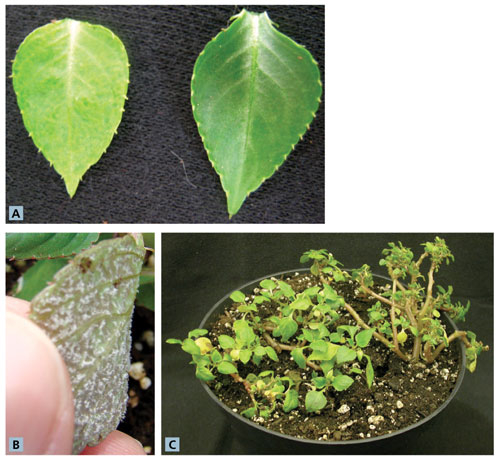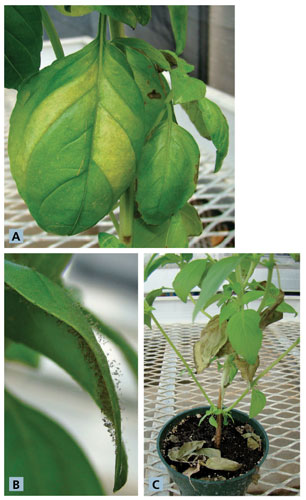1/1/2022
Downy Mildews Are No Fun
Dr. Mary Hausbeck
Downy mildews are destructive and costly—stop them from ruining your crop and leaving a hole in your pocket by unraveling the mystery that surrounds this group of pathogens. While downy mildew may look similar on different types of plants, the pathogens responsible are host-specific.
For instance, the downy mildew on snapdragons cannot blight roses, nor can the downy mildew on impatiens spread to any plant outside of impatiens.
Snapdragons, roses, impatiens, coleus, basil and other crops are all susceptible to different downy mildew pathogens. These pathogens are clever and may initially infect a plant, but then lay quiet in plant tissue until the conditions become favorable (humid and wet) for the pathogen. This can result in plants appearing healthy initially, but then developing symptoms and mildew almost overnight when conditions become humid and wet. In recent years, growers of impatiens and basil have had challenges with downy mildew pathogens.
Impatiens
Impatiens bedding plants have long been known for producing bright, prolific flowers in shady gardens. Other than the pesky Impatiens Necrotic Spot Virus, bedding impatiens were relatively carefree. Then a downy mildew emerged with a particular fondness for bedding impatiens, causing widespread disease. Seed and vegetatively-propagated Impatiens spp., including common seed impatiens (Impatiens walleriana), double impatiens and garden balsam (Impatiens balsamina) are susceptible. Fortunately, New Guinea impatiens (Impatiens hawkeri) are not troubled by downy mildew.
 Figure 1. A) A yellow leaf, which can indicate downy mildew infection, compared to a healthy green leaf. B) Downy mildew fuzz on the underside of a leaf. C) Impatiens stunted by downy mildew infection.
Figure 1. A) A yellow leaf, which can indicate downy mildew infection, compared to a healthy green leaf. B) Downy mildew fuzz on the underside of a leaf. C) Impatiens stunted by downy mildew infection.
The culprit, the water-mold pathogen Plasmopara obducens, rapidly deflowers, defoliates and kills impatiens, challenging greenhouse producers of impatiens, landscapers, and homeowners. Symptoms include yellow and mottled leaves, downward curling of the leaves and plant stunting.
This pathogen reproduces rapidly, producing a vast quantity of white spores (sporangia) on the undersides of diseased leaves (Figure 1A). Infected plants eventually become defoliated and die (Figure 1B).
An important hallmark of this downy mildew of impatiens is its ability to form overwintering spores (oospores) in diseased plants, which can contaminate the soil of landscape beds. When healthy impatiens are replanted in that soil the following season, they may become infected by the oospores causing disease and defoliation of the planting.
Basil
Basil is the top-selling herb in the U.S. From pizza to pesto, sweet basil is widely popular. Downy mildew caused by Peronospora belbahrii is very destructive on basil, including Genovese, Everleaf, Emerald, Dolly and others. Early symptoms include sections of the leaves appearing yellowish (Figure 2A). When the leaves are turned over, the dark mildew can be seen on the undersides (Figure 2B). As more leaves become infected, the plant becomes defoliated (Figure 2C). However, sometimes the leaves can appear entirely green and healthy, but when the leaves are turned over the dark sporangia of the mildew are evident.
 Figure 2. A) A basil leaf infected with downy mildew showing yellow striping.
Figure 2. A) A basil leaf infected with downy mildew showing yellow striping.
B) Spores (sporangia) on the underside of a basil leaf appear dark grey/black.
C) A basil plant infected with downy mildew becomes defoliated.
When scouting basil for evidence of this dark mildew, focus on plants with yellow or brown areas of the leaves and also include plants that appear healthy. Sometimes, a completely green leaf has the downy mildew pathogen happily reproducing on its underside.
In southern regions of Florida, downy mildew on basil is now endemic (naturally occurring) and can overwinter due to the lack of a killing frost. In northern states, basil downy mildew doesn’t overwinter outside and the pathogen must be introduced each year. Seed contaminated with the downy mildew pathogen is widely recognized as a cause of concern. While seed treatments for many crops include hot water, this method for downy mildew on basil seed doesn’t appear to be an option. When basil seed is treated with hot water, a gelatinous exudate oozes from the seed, causing difficulty with both handling and sowing. Efforts to use steam as a seed treatment and advanced methods for detecting the pathogen in seed lots are ongoing.
Be a downy mildew hunter
While there isn’t a “one-size-fits-all” disease management approach, using a coordinated approach can help regardless of which downy mildew pathogen you’re targeting. Since this pathogen is so explosive, early detection is critical. Most downy mildew pathogens produce plenty of sporangia that are moved via air currents to nearby healthy host plants. The downy mildew sporangia form in the dark during the evening and early morning hours when the environment is humid and wet. As the sun rises and the environment begins to dry, the mature sporangia are released into the air and eventually settle onto new plants. Even a small outbreak of one or two diseased plants can go undetected, yet this can enable the pathogen to spread and increase rapidly.
The mildew that develops on the undersides of the leaves is the most important symptom. A sure sign of downy mildew is the “fuzz” on the underside of diseased leaves. Other pathogens, such as Botrytis, can cause some fuzzy leaves, but will not be restricted to the underside of the leaf like downy mildew.
Infected plants should be identified early and disposed of immediately in order to limit the infection of other plants in the greenhouse (landscape/garden/field). When receiving plugs of susceptible Impatiens spp. or sweet basil, look at the fully-expanded leaves, paying special attention to the undersides of the leaves. If there are symptoms of downy mildew infection, such as distorted leaves or yellow foliage—but no mildew on the undersides of the leaves—they still may be infected with the pathogen even though the conditions may not be wet enough for sporangia production. Place any suspect plants in a plastic bag with a wet paper towel and leave it for a couple of days to see if mildew forms on the underside of the leaves.
Established impatiens and basil plants in all production areas should be scouted frequently. Be sure to also check plants that are in baskets and/or mixed containers. When disposing of diseased plants, avoid loading them onto a cart and then rolling it through the production area to the dumpster. Don’t give downy mildew a chance to spread its sporangia throughout the greenhouse! Instead, place the plants with mildew directly into trash bags that are tied before moving them out of the production area into the dumpster.
Diseased plants shouldn’t be placed in a cull or compost pile. Healthy-appearing plants that are right next to the diseased plants should also be discarded, as they’re likely to be infected, but not yet showing symptoms. All remaining impatiens or basil plants anywhere on the premises should be immediately treated with fungicides and watched carefully for any disease development.
Downy mildew likes water and cool temperatures. Limit disease by venting, reducing the time that leaves are wet and keeping relative humidity to a minimum. Water plants at a time of day that allows the foliage to dry quickly. Downy mildew is called a water mold because it needs water to infect plants and develop sporangia on the plant’s surface. Any strategy that reduces water, leaf wetness and relative humidity in a greenhouse will help limit downy mildew.
Adjusting the watering so that the plants aren’t oversaturated helps to decrease the relative humidity around the plant zone. While the optimum temperature for downy mildew is typically around 65F (18C), the pathogen can produce spores at higher temperatures if the environment is wet. If the relative humidity is high and the plants are wet for an extended time, downy mildew can develop under a range of temperatures.
Apply effective fungicides preventively
The MSU Plant Pathology Vegetable and Ornamental lab has been testing fungicides for control of the downy mildew pathogens that infect impatiens and basil for several years. Rotating fungicides based on the mode of action is important.
Impatiens: The fungicides Subdue MAXX, Adorn and Segovis have proven especially effective. Other highly effective fungicides include Stature SC, Micora, Orvego, Segway and FenStop. Additional fungicides that can be considered to provide a fair to good level of control include Alude, Heritage 50WG, Insignia, Pageant Intrinsic, Protect DF and Compass. Subdue MAXX and Segovis are both systemic fungicides and are especially effective when applied as a drench. MSU research has shown that application of highly effective fungicides to impatiens while in the greenhouse provides long-lasting protection even after the plants are established in downy mildew-infested landscape sites.
Basil: New registrations of downy mildew fungicides for use on basil have been secured through the USDA IR-4 Food Use Program. Several effective fungicides are now registered. Growers have choices for fungicide management of basil downy mildew based on the growing environment (greenhouse or field) and intended use (seedlings for field production, greenhouse production for harvest or seedlings for sale to consumers). Strictly adhere to the fungicide label for specifics, including rates, use patterns, pre-harvest intervals and restrictions. Growers concerned about basil seed and potential contamination from downy mildew should apply a fungicide early in the production cycle and continue applications at a regular interval as specified by each fungicide label.
Fungicides that can be considered, depending on the specific production system and intended crop use, include Subdue MAXX, Heritage, Ranman, Revus or Micora, Segovis and phosphorous acid fungicides. For organic basil production, OMRI-certified coppers and other OMRI-certified products can be used for downy mildew, but may not provide a high level of control on a susceptible cultivar.
Tap into genetic resistance
Resistance to pathogens and the diseases that they cause is often the best way to ensure healthy plants. Keep in mind that resistance doesn’t always equal immunity. Immunity refers to the concept that the plant’s genetics are able to completely exclude the downy mildew pathogen. Resistance is an extremely helpful tool and can be combined with an abbreviated fungicide program for an extra layer of protection. For impatiens, cultivars (ie., Imara XDR Impatiens and Beacon Impatiens) have been developed to resist infection by the downy mildew pathogen.
Resistant basil varieties are an especially important defense against an aggressive downy mildew pathogen. Breeders at Rutgers University and the University of Florida are developing downy mildew-resistant basil varieties. Some of these new basil lines have been released and are commercially available. Seed varieties with resistance to downy mildew include Rutgers Obsession, Rutgers Devotion, Rutgers Thunderstruck, Prospera and Proven Winners Pesto Besto. The vegetatively propagated Proven Winners Amazel Basil is also available. GT
This research was supported in part by the Floriculture Initiative of the USDA Agriculture Research Service and the USDA IR-4 Project.
Dr. Mary Hausbeck is a University Distinguished Professor and Extension Specialist at Michigan State University.